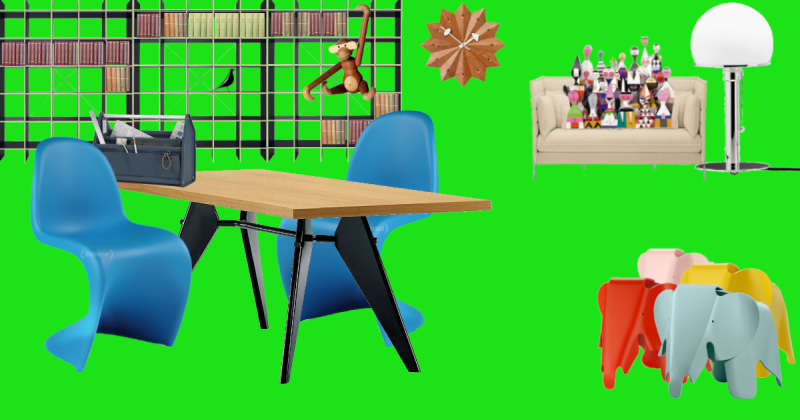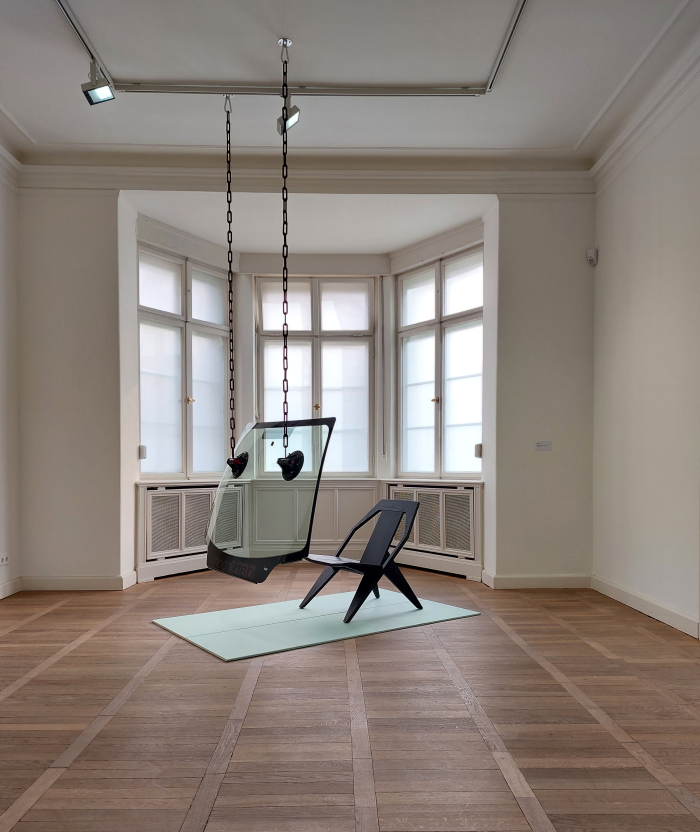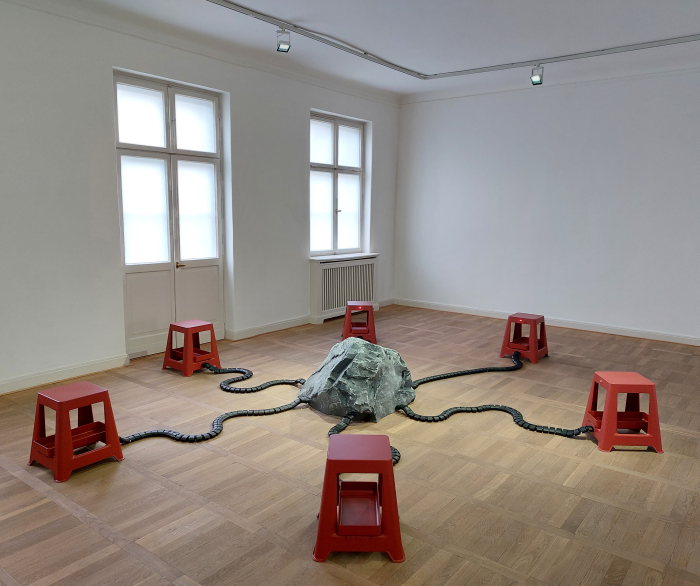Designer | Everyday Design | Product | smow
We were obviously off ill on the day of the great global public debate about whether, given the myriad problems of contemporary societies, our resource emergencies, and the effortless manner in which we've managed to turn the Internet, the greatest tool ever placed at the disposal of a member of the Animalia, into a platform for hate and vanity and greed and crime; if given all that, if we all wanted to, if we all should, move to the Metaverse.
But that debate must have occurred, for the decision has been made; and ever since global society decided of its own free will that we should all move to the Metaverse those Californians who hope to reap billions of dollars from our presence there, can't stop extolling just how utterly brilliant it's all going to be.
Which means that slowly we do all need to start reflecting on our furniture for the Metaverse, start considering how we're going to furnish the Metaverse once we get there......

Questions of furnishing the Metaverse, questions of furniture for the Metaverse, which were very much in our minds as we toured Konstantin Grcic. New Normals at Haus am Waldsee, Berlin, the Metaverse being, as we're all regularly and breathlessly informed, well on its way to becoming part of our new normal; whereby, being the cynics that we are, we naturally question in how far the Metaverse as realised will actually resemble the Metaverse as promised by Californians, how many of us will actually move there, what exactly it is meant to bring us for all given the costs it will invariably come at, how it tackles global inequality, where the necessity is..... amongst a great many other, hopelessly, hopelessly, cynical, questions. However, being also the realists that we are we do very freely subscribe to Douglas Adams' treatise that while "anything invented after you're thirty-five is against the natural order of things", "anything that is in the world when you're born is normal and ordinary and is just a natural part of the way the world works".1
Thus for coming generations not only the Metaverse could well be a thoroughly natural component of the way the world works, but choosing furniture for the Metaverse, considering the furnishing of the Metaverse, could well have, and remaining in the narrative of New Normals, moved from being an alien, unfamiliar, incomprehensible process to something normal and ordinary.
And processes very much in development. Processes, arguably, begun on platforms such as Second Life or Fortnite or Minecraft which allow one to acquire, or in the case of Minecraft build, furniture, and a process towards furnishing the Metaverse to which the exponential rise of NFTs in recent seconds has given a whole new impetus; NFTs allowing as they do individuals to actually own unique pieces of virtual furniture à la design gallery one-offs, while wider blockchain technology allows for the trading of mass produced furniture in a manner akin to that in our physical world, in our Realverse. And which, to varying degrees, is already being employed by/on/in platforms such as Sandbox or Decentraland.
Thus, theoretically, once the Californians have finished building the Metaverse, or heavens forbid Metaverses, the processes necessary to enable the furnishing of the Metaverse should be firmly established and familiar.
But with what should we furnish the Metaverse. With what will we furnish the Metaverse.
Will we furnish the Metaverse?
?

The first question to ask is why do we have furniture?
Or keeping it simple, why do we have chairs?
To sit on, to take the strain off our muscles and joints, to relax in, to allow us to assume appropriate positions for specific tasks.... and a whole host of similar physical functions a virtual avatar doesn't have to contend itself with.
And so doesn't need a chair?
"Need" is a very complex concept, and while a virtual avatar doesn't need a chair for the above physical reasons, chairs are also representative, satisfy representative needs, have representative functions, were previously primarily about representation, the throne being inarguably the best example; chairs' associations with comfort and utility, the demands we place on our chairs for comfort and utility, being, relatively, modern.
A representative function of chairs, of furniture in general, that can be considered very much in context of that which Erving Goffman terms "sign-vehicles" and in context of the development of "front", specifically, the development of the "setting", those/that "furniture, décor, physical layout and other background items which supply the scenery and stage props for the spate of human action played out before, within, or upon it".2 Scenery and stage props which on the one hand act as a mirror reflecting, confirming and validating our own self-image, and on the other contain messages readable by others, messages we consciously transmit and want others to read by way of establishing that impression of ourselves we wish to be known by.
Something humans have long understood and practised as both broadcasters and recipients; the long and detailed descriptions, for example, an Émile Zola provides of the furniture and furnishings in his Rougon-Macquart cycle being very much about enabling contemporary 19th century readers to appreciate the projected image of the protagonists, and also to appreciate the contradictions that often arise between their projected image and their actual behaviour that is so central to many of the works, and also to help contemporary 19th century readers better appreciate the social, financial and political situation in which the various protagonists found themselves; and which remain as signs very coherent and comprehensible to the 21st century reader. Or going even further back, the oft quoted lament of the 1st century Roman philosopher Seneca that, "at the present day a library has become as necessary an appendage to a house as a hot and cold bath. I would excuse them straight away if they really were carried away by an excessive zeal for literature; but as it is, these costly works of sacred genius, with all the illustrations that adorn them, are merely bought for display and to serve as wall-furniture."3 And in a great many 21st century homes bookcases still are about what they say rather than what the (unread) books within them say.
And messages broadcast and received not just in domestic situations, furniture also playing an important role in the "setting", in the "front", in commercial and civic locations, is a component of how companies and institutions represent themselves to customers, clients, investors, visitors and also to their employees, and to potential employees; and a large part of contract furnishing is, and always was, helping companies and institutions achieve the desired internal and external "sign-vehicles" for their lobbies, offices, canteens, etc.
And, for us, there is no reason to doubt that things will be any different in the Metaverse, no reason to doubt that the need for representation through furniture in domestic, commercial and civic domains will remain very strong, that the spaces we furnish in the Metaverse will be extended, multi-layered, Instagram posts. Something tending to be confirmed by the Covid pandemic phenomenon, the Covid pandemic new normal, of people curating the scene behind them for a video call/meeting; and often changing that scenography to suit the specific call/meeting, to influence and inform the specific audience.
And thoughts on furniture as representation which very naturally lead one to a second question: in terms of furniture, what will be representative in the Metaverse?
??

There is an argument to be made that that which is representative in the Realverse will continue to be representative in the Metaverse, the (hi)story of furniture design is after all an aggregative progression not a successive one, that which is doesn't cease to be just because something new comes along, if a particular object's representative value can shift on account of the new contexts they are projected in and into; however, given that the Metaverse is a new space for us to corrupt and defile and ultimately make uninhabitable, there is a strong argument to be made that the objects with the greatest representative value will be those which stand in direct relationship to the new space, those which validate themselves, and take their representative value, through being off and from the new space. Which again isn't new, furniture design throughout the ages has been closely related to architecture, to developments in architecture, has regularly and repeatedly been informed by formal, structural, theoretical and tonal features, and developments, of and in architecture.
And in the dimensionlessness of the Metaverse?
Where are you're points of reference? With what are you communicating? What are you responding to? Yes, the architecture, but where are its points of reference? With what is it communicating? What is it responding to? There is no adjacence in the Metaverse. There is no echo in the Metaverse.
Where do you start?
In addition to being informed by architecture, furniture design throughout the ages has also been closely related to materials, to the development of new materials, to improved understandings of materials, and to new technology enabling new approaches to and applications of materials. And also to limitations of materials.
As previously noted, when first confronted with styropore Arne Jacobsen was, allegedly, "more frightened than convinced of the method’s potentials"4, and that because styropore had no limits, afforded Jacobsen the opportunity to do whatever he wanted, a freedom that, allegedly, "frightened" him. Only once Jacobsen discovered that styropore does have limits, specifically, and as with wood, a minimum effective load-bearing thickness, did he relax and find the space to transform styropore into an Egg. An object that, in many regards, owes a component of its being to Jacobsen challenging that minimum effective load-bearing thickness of styropore.
There are no materials in the Metaverse, no properties to work with, no limits to challenge.
Where do you start?
How do you develop furniture off and from the Metaverse?
???

On the one hand there are those long dreamt, long hoped for, fantasies the Metaverse enables, such as levitation. Marcel Breuer, for example, famously spoke of us all sitting one day on "auf einer elastischen luftsäule"5, "on a resilient column of air": not possible in the Realverse, possible in the Metaverse where the air is as implied as the person sat upon it, and where columns of air adhere to the laws of software not to those of physics. And a development which would make Breuer's steel tube cantilever chairs curious artefacts of a primitive past, would change the reading of the steel tube cantilever, change the message they transmit in the Metaverse, change their representation; lead to a very instructive evolution of the representative function of furniture as being relative to context.
On the other hand the Metaverse offers the opportunity to take existing concepts to currently unimaginable places. Modular furniture, for example, is often limited in the Realverse by not only the laws of physics but also the laws of economics; while one could theoretically offer a limitless number of modules for any given system the greater many wouldn't sell in relevant numbers, would thereby be prohibitively expensive to produce and distribute, and so one focuses on those modules that can be sold at a price customers are willing to pay. In the Metaverse such economic considerations are of much less relevance, and so modular systems can exist at the limitless scale at which they make the most sense and at which they can express themselves most satisfyingly. And that as either commercial or non-commercial systems: projects such as, for example, OpenStructures become much more universal and approachable in a world where technical skills are an utter irrelevance, a world where imagined ≡ exists and where everyone is, can be, empowered to employ a basic toolbox to meet their own individual needs. "Who decides, [what furniture is available]”, asked Verner Panton, “the customer, the man on the street, the furniture dealer, the designer or the manufacturer?"6 In the Metaverse through toolbox systems such as OpenStructures the answer can shift towards the customer, where it inarguably should be but rarely is. And for all that the Metaverse is a commercial platform, for all the Metaverse is a platform for advancing commerce, for advancing the economy of California, why can't it also be a chance to exploit the collaborative, synergetic potential of networked digital technology for the common good?
But such are all future contemporary expressions of the existing, what about new ideas, can one develop new furniture, new furniture concepts, new furniture genres, off and from the Metaverse?
Can one develop new furniture for a dimensionless, materialless, lawless domain?7
????

Invariably.
But not until that dimensionless, materialless, lawless domain is constructed and we're there and have settled in.
For in the Metaverse there will, invariably, inarguably, despite what we all think, be reference points, if not necessarily physical or of a type we would recognise today, and there will be limitations, if not necessarily physical or of a type we would recognise today: reference points and limitations that will allow for the development of thoroughly new typologies and forms of furniture for the new space. And that because in addition to arising in context of, informed by and in communication with architecture, materials and technology, furniture also arises in context of, informed by and in communication with the culture and society wherein it develops. And the Metaverse will, invariably, develop a culture of its own, will develop a culture distinct from, while not independent of, the Realverse. And thus will, must, can do no other but, develop its own furniture as a response to, exploration of and expression of that new culture.
But that process, more likely processes, can't begin in the Realverse. Can only exist in communion with the development of the Metaverse. Are processes that for all they are thoroughly unfathomable in the Realverse, will be self-evident in the Metaverse.
Thus before the Metaverse exists the only thing we can truly be certain of is that the Metaverse will have Monobloc chairs, because everywhere has Monobloc chairs. And we can also be certain that there will be plagiarists; plagiarists who will (in all probability) be able to work with total impunity in that unpoliceable virtual domain.
Which doesn't mean we can't start, shouldn't start, reflecting on furnishing the Metaverse, for reflecting on furniture and furnishings in context of the Metaverse enables not only differentiated perspectives on the physical functions of furniture, on the technical functions of furniture, on the representative functions of furniture, on the emotional functions of furniture, on the Gebrauschpatina, the Patina of Use, that a Karl Clauss Dietel puts at the core of our relationships with objects8; but reflecting on furniture and furnishings in context of the Metaverse also enables differentiated perspectives on our aesthetic understandings in context of our furniture, on the role and function of furniture designers in and to a society, on the mechanisms by which new furniture arises and achieves its validity, on how we produce and distribute our furniture, on the demands we make of the spaces we inhabit, on why we make those demands of those spaces, on our "need" for furniture and furnishings: on our relationships, individually and collectively, with furniture.
Whereby that Metaverse in context of which one reflects needn't be a potential new virtual California that may or may not arise, but could be the Realverse in a couple of generations time, which definitely will arise9, and which will be, without question, a world utterly unfathomable to contemporary understandings; a world which if it could be viewed today would appear before us as a dimensionless, materialless, lawless domain with neither reference points nor limitations.
1Douglas Adams, "rules that describe our reactions to technologies", undated, printed in Douglas Adams, The Salmon of Doubt, Pan Books, 2012, page 95
2Erving Goffman, The Presentation of Self in Everyday Life, Penguin Books, 1990, page 32
3Seneca, Minor dialogues, together with the dialogue on clemency. Translated by Aubrey Stewart, Bohn’s Classical Library, G Bell, London, 1889, page 271
4Carsten Thau and Kjeld Vindum, Arne Jacobsen, Architektens Forlag, Copenhagen, 2002, page 468
5Marcel Breuer, ein bauhaus-film. fünf jahre lang, bauhaus. zeitschrift für gestaltung Nr. 1, 1926
6Verner Panton: Mine Design-Philosophie, BÜROszene, Vol 47, Nrs. 1–2, 1995 Although first published in 1995, it is (based on) a speech Panton held several times in the 1980s.
7Lawless here is very much meant in terms of physical laws, but clearly the Metaverse will be a thoroughly lawless void in all contexts
8Clauss Dietel, Von den veredelnden Spuren des Nutzens oder Patina des Gebrauchs, Form+Zweck, 1973 Nr. 1. Accessible via https://digital.slub-dresden.de/werkansicht/dlf/131246/1 (accessed 07.02.2022)
9You're right, it may not arise, it's not definite, but let's stay optimistic, let's assume we manage to change for the better.......
And a world which, unlike the Californian Metaverse(s), we all have a say in the forming of.......